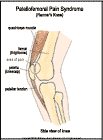
Patellofemoral Pain Syndrome (Runner's Knee)
What is patellofemoral pain syndrome?
Patellofemoral pain syndrome is pain behind the kneecap. It has been given many names, including patellofemoral disorder, patellar malalignment, runner's knee, and chondromalacia.
How does it occur?
Patellofemoral pain syndrome can occur from overuse of the knee in sports and activities such as running, walking, jumping, or bicycling.
The kneecap (patella) is attached to the large group of muscles in the thigh called the quadriceps. It is also attached to the shin bone by the patellar tendon. The kneecap fits into grooves in the end of the thigh bone (femur) called the femoral condyle. With repeated bending and straightening of the knee, you can irritate the inside surface of the kneecap and cause pain.
Patellofemoral pain syndrome also may result from the way your hips, legs, knees, or feet are aligned. This alignment problem can be caused by your having wide hips or underdeveloped thigh muscles, being knock-kneed, or having feet with arches that collapse when walking or running (a condition called over-pronation).
What are the symptoms?
The main symptom is pain behind the kneecap. You may have pain when you walk, run, or sit for a long time. The pain is generally worse when walking downhill or down stairs. Your knee may swell at times. You may feel or hear snapping, popping, or grinding in the knee.
How is it diagnosed?
Your health care provider will review your symptoms, examine your knee, and may order knee x-rays.
How is it treated?
Treatment includes the following:
- Place an ice pack on your knee for 20 to 30 minutes every 3 to 4 hours for the first 2 to 3 days or until the pain goes away
- Elevate your knee by placing a pillow underneath your leg when your knee hurts.
- Take anti-inflammatory pain medication, such as ibuprofen, as prescribed by your health care provider.
- Do the exercises recommended by your health care provider or physical therapist.
Your health care provider may recommend that you:
- Wear custom-made arch supports (orthotics) for over-pronation.
- Use an infrapatellar strap, a strap placed beneath the kneecap over the patellar tendon.
- Wear a neoprene knee sleeve, which will give support to your knee and patella.
While you are recovering from your injury, you will need to change your sport or activity to one that does not make your condition worse. For example, you may need to bicycle or swim instead of run. In cases of severe patellofemoral pain syndrome, surgery may be recommended. Your health care provider will show you exercises to help decrease the pain behind your kneecap.
When can I return to my sport or activity?
The goal of rehabilitation is to return you to your sport or activity as soon as is safely possible. If you return too soon you may worsen your injury, which could lead to permanent damage. Everyone recovers from injury at a different rate. Return to your sport or activity will be determined by how soon your knee recovers, not by how many days or weeks it has been since you were injured. In general, the longer you have symptoms before you start treatment, the longer it will take to get better.
You may safely return to your sport or activity when, starting from the top of the list and progressing to the end, each of the following is true:
- Your injured knee can be fully straightened and bent without pain.
- Your knee and leg have regained normal strength compared to the uninjured knee and leg.
- You are able to jog straight ahead without limping.
- You are able to sprint straight ahead without limping.
- You are able to do 45-degree cuts.
- You are able to do 90-degree cuts.
- You are able to do 20-yard figure-of-eight runs.
- You are able to do 10-yard figure-of-eight runs.
- You are able to jump on both legs without pain and jump on the injured leg without pain.
How can I prevent patellofemoral pain syndrome?
Patellofemoral pain syndrome can best be prevented by strengthening your thigh muscles, particularly the inside part of this muscle group. It is also important to wear shoes that fit well and that have good arch supports.

